

Impact of Climatic Variations on the Caribbean region Hurricanes Meeting July 20-21, 1999 Miami, Florida By Stan Goldenberg NOAA AOML/Hurricane Research Division 4301 Rickenbacker Causeway Miami, Florida 33149stan.goldenberg@noaa.gov
Some information is from "What About Shutters"
(OAR/NWS/NOAA)
With the current increase in number and intensity of Caribbean region hurricanes, a new focus needs to be placed on the issue of preparedness. Although hurricane-track forecast errors have been decreasing on the average (i.e., forecasts have been improving), the accuracy still leaves much to be desired. In addition there are major problems with hurricane intensity forecasts. Even if residents have perfect track and intensity forecasts, however, they still need to understand how to respond to the danger posed by an approaching hurricane. Obviously, there are certain cases when evacuation is the only effective answer such as sub-standard housing (mobile homes, huts, etc.) which would be easily destroyed by the winds and areas affected by deadly storm surge (or even rain produced) flooding. Well-built structures still need the added protection of hurricane shutters, however. Without shutters, substantial damage can still be experienced even if the main structure is not affected due to window breakage and the intrusion of the hurricane winds and rain into the building. Well-designed shutters can result in substantially reduced damages. There are a number of commercial shutters on the market and various hand-made plywood designs. It is important for the public to become informed about which types of shutters are the most effective. Obviously, the more effective types of shutters need advanced preparations. It is oftentimes difficult or impossible to obtain the materials and to construct or install the shutters after a hurricane watch or warning is already in place.
What are the best shutters? The best kind are those that are affordable, are easy to install, and offer the greatest protection. Which of these properties is most important depends on individual circumstances. For a disabled or elderly person it may be ease of installation with either an automatic closing mechanism or accordion type shutters. For those with limited incomes plywood shutters may be the only affordable option. For most people the best compromise would be steel panels, which offer good protection, but are certainly more expensive than plywood. The most worthless type of protection is the often employed use of various types of tape over the windows. This practice does little or nothing to prevent breakage, may result in large, more dangerous pieces of flying glass, and is extremely difficult to remove after the storm.
Some people are experiencing a certain level of protection by covering their windows with special impact resistant protective film. Others are using a new type of impact-resistant storm window. Various types of commercial storm shutters can be effective but many are untested and have been found to fail in stronger hurricanes (e.g., Hurricane Andrew in 1992). Miami-Dade county (Florida) now requires that all commercial shutters pass rigorous tests before they can be approved for sale and installation. It is recommended that commercial shutters are not used that have not passed these types of tests. The shutters range from the most inexpensive (but still highly effective) metal corrugated panels type -- aluminum or steel (heavier but stronger!) to electrically operated roll-down shutters, also effective if properly constructed.
Many people, however, cannot afford any type of commercial shutter. Most resort to using plywood attached to the structure using various types of methods. The least effective method, used by many people with minimal time to prepare, is to let the plywood overlap the window opening and attach it to the structure using concrete nails. This technique can cause more harm than good since in even moderately high winds, most of these poorly-attached boards will be ripped off and become dangerous flying missiles! The most publicized method is to cut the board to overlap the window opening and then use tapping screws through the wood fastened into lead sleeve anchors in the wall. Although better than the first method, many boards attached using this technique have failed in the more intense hurricanes. If the windows have at least a 2-inch inset there is a much more effective technique to use with plywood. Plywood shutters made with this second technique performed extremely well even in the maximum winds of Hurricane Andrew when it hit South Miami. Most people can construct this special type of plywood shutter with only reasonable effort and cost. The basic concept that the wood is cut to fit inside the inset of the window and is fastened to the windowsill using barrel bolts. The design is effective for two main reasons. Firstly, because the wood is recessed, the hurricane winds cannot get under the wood. Secondly, because the wood is fastened perpendicular to the force of the wind (both the forces that try to push the shutter into the house and the forces that can work to suck the shutter away from the structure) it is far more difficult for the wind to pull the fasteners out from the structure. Figures describing this design are included at the end of this summary. Note that there are other, equally effective, attachments methods for this particular technique. The main characteristics need to be that the wood fits inside the inset and that the fastening is into the inset (windowsill).
Plywood shutters are an inexpensive alternative to commercial shutters, but it should be noted that they do NOT meet the specification of the South Florida Building Code and they do require a good deal of physical labor to manufacture and install them.
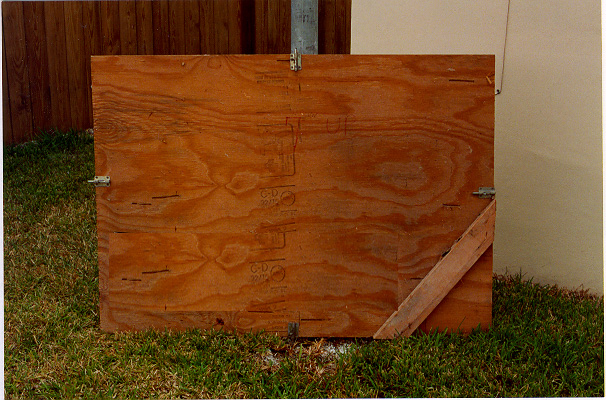 You should use at least 5/8 inch exterior grade plywood, which
is substantial enough to sustain an impact by windborne debris,
but which is also heavy and hard to work with. You should also
buy heavy duty 3 or 4 inch barrel bolts, at least four per panel,
more for larger openings. The better the quality of materials
you use the less likely they will fail in a hurricane.
You should use at least 5/8 inch exterior grade plywood, which
is substantial enough to sustain an impact by windborne debris,
but which is also heavy and hard to work with. You should also
buy heavy duty 3 or 4 inch barrel bolts, at least four per panel,
more for larger openings. The better the quality of materials
you use the less likely they will fail in a hurricane.
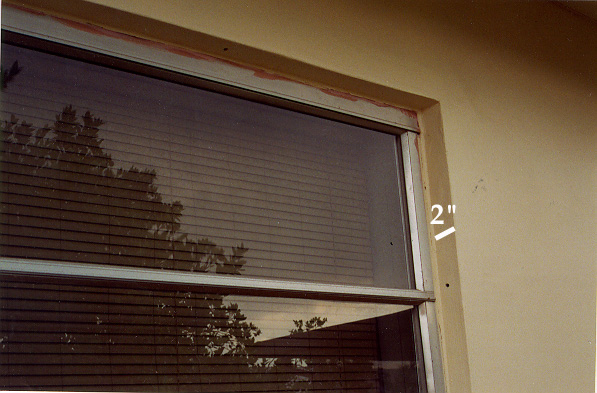 There ought to be at least 2 inches inset of the window
from the exterior wall since the plywood will be mounted
inside this recess. For windows and doors without enough
inset you may have to fasten the plywood to the outside
wall, which makes them vulnerable to being pulled off by
high winds.
There ought to be at least 2 inches inset of the window
from the exterior wall since the plywood will be mounted
inside this recess. For windows and doors without enough
inset you may have to fasten the plywood to the outside
wall, which makes them vulnerable to being pulled off by
high winds.
Each window and door to be covered should be carefully measured
and a piece of plywood cut to fit snugly inside the opening.
A good fit is extremely important for the window to be
protected. Some window frames may not be square, so be sure to
carefully measure each side and corner angle and cut the
plywood to fit. This makes it important to mark which side of
the panel is on top, and which side should face out. Also
write on the panel which window or door it is meant to cover.
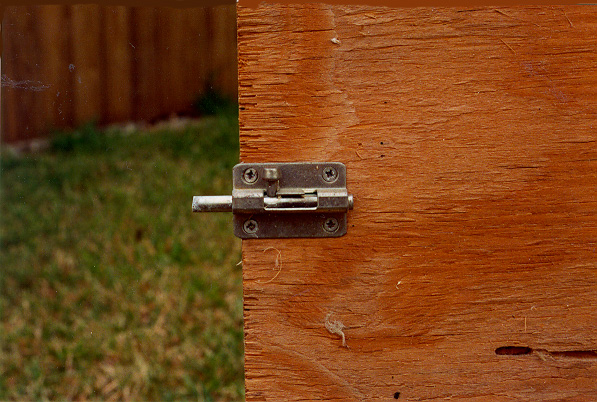 Screw the barrel bolts to the panel, one on each side in
the middle for smaller windows. For larger windows and doors
there should be a bolt every 18 inches or so. Also larger
panels may need handles or braces to make them easier to
maneuver. For panels covering very large areas (such as
sliding glass doors) you can use a piano hinge to make the
panel easier to fold, handle, and store.
Screw the barrel bolts to the panel, one on each side in
the middle for smaller windows. For larger windows and doors
there should be a bolt every 18 inches or so. Also larger
panels may need handles or braces to make them easier to
maneuver. For panels covering very large areas (such as
sliding glass doors) you can use a piano hinge to make the
panel easier to fold, handle, and store.
Now place the plywood up against the window, and mark where
each barrel bolt slides up against the wall.
 Once you've made all the marks remove the panel
and drill the bolt holes into the concrete. Use a drill bit
just large enough to accomodate the bolt. Try to install
the panel to be sure of the fit and that the bolts engage the
holes properly. Make whatever adjustments are necessary.
Once you've made all the marks remove the panel
and drill the bolt holes into the concrete. Use a drill bit
just large enough to accomodate the bolt. Try to install
the panel to be sure of the fit and that the bolts engage the
holes properly. Make whatever adjustments are necessary.
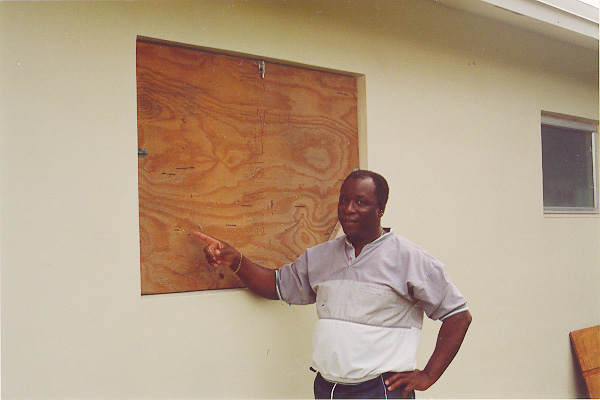 If you need to place the panels on the outside exterior wall
then instead of cutting the plywood to fit inside the
window inset it should be cut to leave at least 4 inches
around the opening. And instead of barrel bolts you should
use lag bolts, washers, and lead anchors.
If you need to place the panels on the outside exterior wall
then instead of cutting the plywood to fit inside the
window inset it should be cut to leave at least 4 inches
around the opening. And instead of barrel bolts you should
use lag bolts, washers, and lead anchors.
After cutting a panel for a given window or door write on it
which opening it is for and which is the top side. Mark
where each bolt is to go, about every 18 inches around the
outside, about 2 inches in from the edge. While holding
the panel in place have someone drill a bolthole at each
mark through the plywood and the wall. It should be just
large enough for the bolt to fit through and deep enough to
accomodate the lead anchor. When all holes are drilled
remove the panel and re-drill the holes in the wall large
enough to accept the anchor. Clear each hole of plaster
and then cement an anchor in each. After the cement has set,
go back and try to fasten the panel to the wall to make sure
everything is aligned. Use a washer on each bolt to help it
hold the panel in place. Make whatever adjustments are
necessary.
For more instructions on other ways to install plywood shutters click on
the FEMA site
or the
USA Today site.
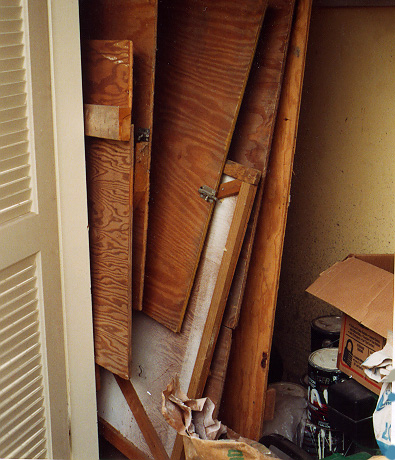 Once your panels are done you may waterproof them with a coat
of varnish or paint (just don't paint over your markings).
Find a dry, cool place to store them since heat and moisture can
warp plywood and ruin their fit.
Once your panels are done you may waterproof them with a coat
of varnish or paint (just don't paint over your markings).
Find a dry, cool place to store them since heat and moisture can
warp plywood and ruin their fit.
Photos by Stan Goldenberg.